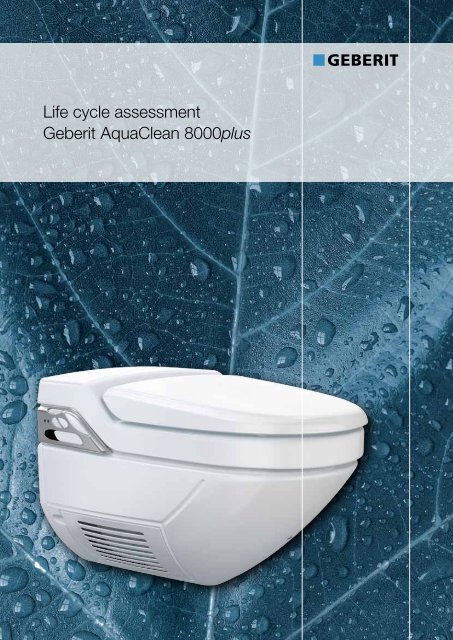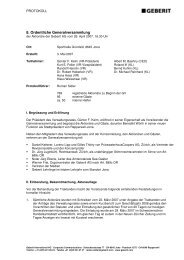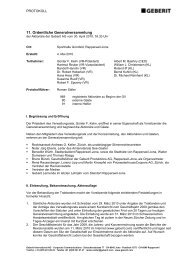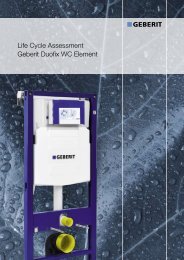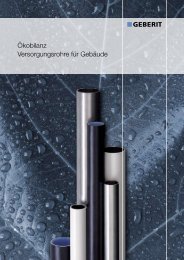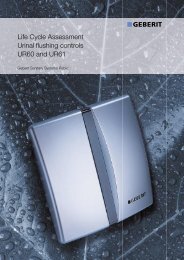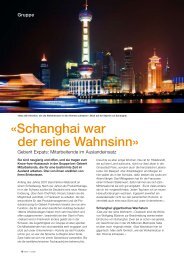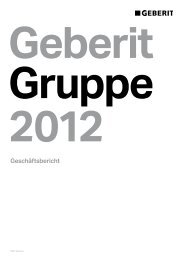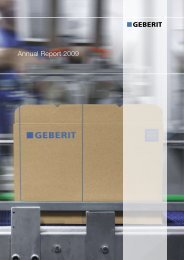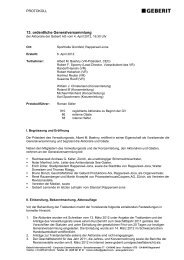Life cycle assessment Geberit AquaClean 8000plus
Life cycle assessment Geberit AquaClean 8000plus
Life cycle assessment Geberit AquaClean 8000plus
Create successful ePaper yourself
Turn your PDF publications into a flip-book with our unique Google optimized e-Paper software.
<strong>Life</strong> <strong>cycle</strong> <strong>assessment</strong><br />
<strong>Geberit</strong> <strong>AquaClean</strong> <strong>8000plus</strong>
Starting point of the life <strong>cycle</strong> <strong>assessment</strong><br />
The <strong>Geberit</strong> <strong>AquaClean</strong> <strong>8000plus</strong> is a WC which enables comfortable and hygienic cleaning<br />
with water in the anal and vaginal area. The life <strong>cycle</strong> <strong>assessment</strong> can help answer<br />
the question of how this device should be judged from an environmental perspective.<br />
Subject of the <strong>assessment</strong><br />
The <strong>AquaClean</strong> <strong>8000plus</strong> is a WC<br />
which enables comfortable and<br />
hygienic cleaning with water in the<br />
anal and vaginal area. Its main<br />
functions include cleaning with a<br />
spray of water after using the WC,<br />
drying with a warm-air dryer and<br />
automatic cleaning of the spray arm.<br />
The use of a conventional WC<br />
(including the use of toilet paper and<br />
wet wipes) was examined for the<br />
purpose of comparison. The use of<br />
a bidet was also assessed as an<br />
additional variant.<br />
Functional unit<br />
The use of the <strong>AquaClean</strong> <strong>8000plus</strong><br />
by a family of four people over the<br />
course of one year was chosen as<br />
the functional unit.<br />
System boundaries<br />
The <strong>assessment</strong> spans all life <strong>cycle</strong><br />
phases of the product, from the<br />
provision of the raw materials and<br />
energy carriers through to the<br />
manufacture of the <strong>AquaClean</strong><br />
<strong>8000plus</strong>, its use and eventually<br />
its disposal. As with a conventional<br />
WC, the installation and dismantling<br />
are not taken into consideration.<br />
Production-related assumptions<br />
The energy consumed during the<br />
manufacture of the individual<br />
components and the final assembly<br />
was taken into account.<br />
Use-related assumptions<br />
The <strong>assessment</strong> was based on<br />
the assumption of use by a family<br />
of four, whereby each person<br />
defecates once and urinates four<br />
times per day.<br />
The use of water, electricity and<br />
other consumables was taken into<br />
consideration.<br />
Extensive measurements were taken<br />
in order to determine the amount of<br />
water and electricity used, based on<br />
the factory settings. The following<br />
main scenarios were examined:<br />
– Boiler ON (water spray constantly<br />
at 37°C)<br />
– Boiler UI (user identification,<br />
heating as required)<br />
– Boiler OFF (water spray unheated)<br />
For the WC, the use of toilet paper<br />
(three layers, made from virgin fibres)<br />
and wet wipes was also taken into<br />
account. For this it was assumed<br />
that 15 sheets are necessary during<br />
each use of the WC for defecation.<br />
For cleaning with the bidet, the<br />
additional warm water (2 litres) and<br />
toilet paper (8 sheets) used were<br />
taken into account.<br />
Disposal-related assumptions<br />
It was assumed that the ceramic<br />
elements are disposed of at a landfill<br />
for inert materials, the metal parts<br />
are re<strong>cycle</strong>d, the electronic components<br />
are salvaged separately<br />
and the remaining components<br />
(esp. plastics) are incinerated.
EIP99<br />
Results of the life <strong>cycle</strong> <strong>assessment</strong><br />
The conventional WCs (including the use of ordinary toilet paper) and the <strong>Geberit</strong><br />
<strong>AquaClean</strong> <strong>8000plus</strong> produced comparable life <strong>cycle</strong> <strong>assessment</strong> results. The manufacture<br />
of the toilet paper and the electricity used for heating the water play a central role in this.<br />
Analysis of the results<br />
The graph shows the environmental<br />
impact of the <strong>AquaClean</strong> <strong>8000plus</strong><br />
in comparison with the WC and<br />
bidet in Eco-indicator points (EIP99),<br />
evaluated using the Dutch life <strong>cycle</strong><br />
<strong>assessment</strong> method.<br />
6.0<br />
5.0<br />
4.0<br />
3.0<br />
2.0<br />
1.0<br />
0.0<br />
Boiler ON<br />
Boiler UI<br />
Boiler OFF<br />
WC with toilet paper<br />
Bidet<br />
Sanitary equipment Electricity Water<br />
Paper Other consumables<br />
In terms of environmental friendliness,<br />
the <strong>AquaClean</strong> <strong>8000plus</strong> is<br />
comparable with the use of a<br />
conventional WC including the use<br />
of ordinary toilet paper.<br />
The additional use of wet wipes<br />
produces approximately the same<br />
result as the use of dry toilet paper.<br />
However, the dermatological effects<br />
and composition of the wet wipes<br />
were not investigated.<br />
With the <strong>AquaClean</strong> <strong>8000plus</strong>, it is<br />
the utilisation phase – particularly the<br />
use of electricity for heating the water<br />
– that has the greatest impact on the<br />
environment. The impact caused by<br />
use is twice as high as the impact<br />
produced by the manufacture and<br />
disposal of the sanitary equipment.<br />
The additional water used for anal<br />
cleaning plays a secondary role.<br />
With the conventional WC and<br />
cleaning with toilet paper, the quality<br />
of the toilet paper used plays a<br />
substantial role. There is a factor of<br />
two to four, depending on the<br />
<strong>assessment</strong> method, between toilet<br />
paper made from 100% re<strong>cycle</strong>d<br />
fibres and toilet paper made from<br />
100% virgin fibres.<br />
From an environmental perspective,<br />
the use of a bidet for anal cleaning<br />
produces a significantly poorer<br />
performance than the <strong>AquaClean</strong><br />
<strong>8000plus</strong>. With the bidet, the toilet<br />
paper used for initial cleaning and<br />
the electricity used for heating the<br />
water to 37°C play a significant role.<br />
Here, too, the utilisation phase is key.<br />
Recommendations<br />
– Switch the boiler to user identification<br />
mode (Boiler UI), i.e. to heat<br />
only when required – this reduces<br />
the environmental impact by at<br />
least 10%.<br />
– Turn off the boiler (Boiler OFF) –<br />
this reduces the environmental<br />
impact by around 50%.<br />
– Reduce the temperature of the<br />
water spray, e.g. from 37°C to<br />
33°C – this reduces the environmental<br />
impact by 20%.<br />
– Use green electricity sources<br />
(hydroelectric, wind, photovoltaic<br />
power) – this reduces the environmental<br />
impact by more than 50%.<br />
The <strong>AquaClean</strong> <strong>8000plus</strong> will then<br />
perform better than a WC with<br />
the use of ordinary toilet paper.
EIP99<br />
Analysis of the<br />
<strong>Geberit</strong> <strong>AquaClean</strong> range<br />
5.0<br />
4.0<br />
3.0<br />
2.0<br />
1.0<br />
0.0<br />
<strong>AquaClean</strong> 4000<br />
<strong>AquaClean</strong> 5000<br />
<strong>AquaClean</strong> 5000plus<br />
<strong>AquaClean</strong> 8000<br />
<strong>AquaClean</strong> <strong>8000plus</strong><br />
WC with toilet paper<br />
Sanitary equipment Electricity Water<br />
Paper Other consumables<br />
Analysis of other <strong>Geberit</strong> <strong>AquaClean</strong> models<br />
– The WC enhancement solutions analysed, <strong>Geberit</strong> <strong>AquaClean</strong> 4000 (with<br />
warm water cleaning), <strong>Geberit</strong> <strong>AquaClean</strong> 5000 (with warm water cleaning and<br />
odour extraction) and <strong>Geberit</strong> <strong>AquaClean</strong> 5000plus (with warm water cleaning,<br />
odour extraction, dryer and remote control), perform approximately 10% to<br />
25% better than WCs with ordinary toilet paper.<br />
– The <strong>Geberit</strong> <strong>AquaClean</strong> 8000 (with warm water cleaning) produces somewhat<br />
poorer results than the <strong>AquaClean</strong> <strong>8000plus</strong> despite having fewer comfort<br />
features, as drying with paper has a greater impact on the environment than<br />
the warm-air dryer.<br />
– Electricity consumption plays a significant role in all models and varies between<br />
70 kWh and 130 kWh per year depending on the model.<br />
– The additional water used for anal cleaning plays an insignificant role and<br />
amounts to between 0.5 and 1.5 litres per cleaning depending on the model.<br />
Full report<br />
The present life <strong>cycle</strong> <strong>assessment</strong> was produced in collaboration with the EMPA<br />
(The Swiss Federal Laboratories for Materials Testing and Research). We would<br />
be happy to send you the full report on the product life <strong>cycle</strong> <strong>assessment</strong> (as of<br />
December 2008) upon request. Please note that it is only available in German.<br />
Please contact the relevant distributor in your country or the Environment/<br />
Sustainability department of the <strong>Geberit</strong> Group.<br />
<strong>Geberit</strong> AG<br />
Schachenstrasse 77<br />
CH-8645 Jona<br />
T +41 55 221 63 00<br />
F +41 55 221 67 47<br />
sustainability@geberit.com<br />
www.geberit.com


